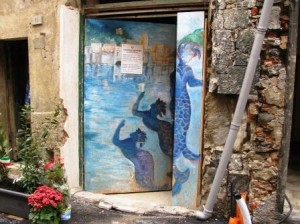What to Do When You’ve Lost Everything. Create.
by Gina Simmons, Ph.D.
Many folks in the U.S. and around the globe now face serious financial losses. Many have lost family, friends, homes and communities in the aftermath of natural and human disasters. How do you get up in the morning and face the cruel day after something that devastating? I suggest two steps.
- Surrender to the process of change. When you lose important things and people it can feel as if you’ve been tossed into a swirling sea of confusion and fear. If you surrender to the notion that life is change, you waste less energy trying to fight the current. That energy will help you rebuild after the storm passes.
- Create something. Creative arts projects help burn victims to cope with pain and heal faster. Research shows that art and music reduce depression, pain and anxiety. Music and art help those in intensive care units relax, use less pain medication, and leave the hospital a day earlier than those in rooms without art or music. Creation activates your neurophysiology to deaden pain and motivate healing.
On October 25, 2011, the town of Vernazza, in the beautiful Cinque Terre region of Italy, faced a devastating flash flood and mudslide. Battered by 22 inches of rain in four hours, they were buried in three meters of mud. Families lost loved ones, homes were destroyed and many faced economic ruin. When I visited the region months later I saw that artists had painted beautiful murals on temporary plywood doors that faced the street on the devastated ground floor homes. I include photographs of some of those paintings here. Some artists captured the grief of lost life, while others used hopeful imagery suggesting rebirth. The art reminded residents and visitors that this area, known for its great beauty, would bloom again.
Creativity helped victims of hurricane Katrina survive, generate hope, and rebuild. The flexibility of thinking we normally associate with creativity helps us survive in times of disaster. After the hurricane hit Louisiana, on August 29, 2005, a group of volunteers quickly created People Finder, an online aggregate site to coordinate information about missing people. They started with a creative idea, a need and a group of volunteers working on a common goal. The site processed well over a million searches by October 2.
Neurologist and holocaust survivor, Victor Frankl, found meaning in his creative imagination during the three year ordeal where he was imprisoned in concentration camps. He found scraps of paper to use to write a memoir of his life in the camps. He would give lectures to an imaginary audience on topics like, “Psychotherapeutic Experiences in a Concentration Camp.” He found creative comfort in the power of his imagination to find meaning in his experience. He wrote, ” I understood how a man who has nothing left in this world still may know bliss, be it only for a brief moment, in the contemplation of his beloved.”
Creativity occurs in the imagination, in actions both precise, such as stitching a fine needlepoint, or kinetic like an improvised modern dance. It can occur in the simple stacking of stones on a hiking trail, or the complex detail of a Tibetan sand painting. Negative emotions like grief, anger and sadness lend themselves to solo efforts that require attention to detail, such as quilting or woodworking. Positive emotions open us to more flexibility and allow us to engage in community efforts such as Habitat for Humanity or community mural projects like Groundswell , and the works of artist Tobie Roach.
You don’t need to be a trained artist to create. Children do it all the time. They put paint on their fingers and smear it around. Children imagine they have super powers and fly about with capes made of beach towels. When you try jewelry making, poetry, music, creative writing, gardening, programming projects and other exercises of your imagination, you lessen the pain of loss, and begin to feel alive again. Your brain and body better recover from loss and trauma and reorganize to a new normal. It all starts with letting go of expectations and opening to new possibilities. If you’re not sure how to start, explore something strange, new, unfamiliar. Then let the ideas flow without judging or criticizing them as good or bad, worthy or unworthy. When you find something that pleases you a little, that’s where you should begin.



Well I lost it all including my music people I trusted family and “friends” my truck my girl my credit my band and I am alone and have no place to start and rebuild. So I really think this works only for a select few who are not on the brink of suicide .
So sorry that you feel so alone and unsure where to start. It is possible to rebuild, even after feeling so much despair. Start with finding free or low cost counseling through a hotline or community clinic. Counselors can help you think about things in a new way. Support groups help too. You can get referrals from the American Psychological Association website and the American Association of Marriage and Family Therapist website. Best wishes.